


ORGANS OF PARIS © 2024 Vincent Hildebrandt HOME ALL ORGANS
Saint Dominique
16, rue de la Tombe-Issoire, 75014 Paris

The Church of Saint-Dominique is quite recent in
construction since it was completed in 1921. It is the
work of the architect Georges Gaudibert, who was
inspired by the Romano-Byzantine style. One of its
peculiarities is its East eardrum on the outside for which
the sculptor André Bourroux placed in 1946 a high relief
representing Saint-Dominique in the guise of ... actor and
director Louis Jouvet who posed for the artist.
Organiste titulaire
Julien Lucquiaud
Concerts
-
Masses woth organ
Saturday 6:30, Sunday 9, 10:30 AM, 6:30 PM
Videos
Julien Lucquiaud
Photos de l’orgue : Julien Lucquiaud
Count Christian de Bertier de Sauvigny was born on
April 10, 1864. Coming from an old family of Burgundian
origin, he studied organ with M. Wakanthaler, organist of
Dijon Cathedral, then in Paris with Eugène Gigout and
Henri Dallier. He was the assistant organist of the churches
of Saint Eustache and La Madeleine, he was then titular of
the organ of the church of Saint Antoine des Quinze-Vingts
in the 12th arrondissement, from 1909 to his death in
1939.
In 1904, Count Bertier had an organ built by Merklin for his
mansion located at 14 rue Legendre in the 17th
arrondissement (14 rue Georges Berger since 1912). The
organ was placed in the spacious 6-metre-high artist's
studio, located on the 2nd floor of the mansion. The organ
was inaugurated on Thursday, May 19, 1904 by Eugène
Gigout, organist of the church of Saint Augustin in Paris,
and by Henri Dallier, organist of the church of Saint
Eustache in Paris. On the program of this inauguration,
works by Bach, Saint-Saens, Dubois, Boëllmann, Gigout
and Dallier. The instrument then has 28 stops, spread over
three keyboards of 56 notes, including 2 expressive, and a
pedalboard of 30 notes. Many organ concerts were held at
the home of Count Bertier. According to Les archives
bibliographiques contemporaines, années 1906-1917, the
Count organized each year, at his home, "very well
attended organ auditions in honor of the laureates of the
National Conservatory of Music".
In the early 1920s, Count Bertier and his wife left the hotel
on rue Legendre to settle in a more spacious mansion at 7
rue de Poitiers.
However, the Merklin organ did not seem to find its place
in any of the rooms of this mansion. According to the plans
of the latter, the ceiling height of the reception rooms was
3.80 m while the height of the organ rised to 5 meters. On
November 20, 1923, Count Bertier filed a building permit, it
was the construction of an annex in the courtyard of his
mansion, between the main building and outbuildings. The
architect's plans detail the construction of a "gallery"
containing an organ. The façade of the organ case was
slightly reworked and adapted to the dimensions of the
new hall and the composition was increased by 3 new
stops: a 4' Clairon, a Nasard and a 4' Flûte douce, the 5' 2/3
pedal Quinte was transformed into a 10' 2/3 Quinte. At the
level of the couplings, new low and high octaves were
added. These transformations were carried out by Gaston
Gutschenritter, Merklin & Cie.
At this new address, many concerts were held. An evening
was organized there on March 12, 1931, in honor of the
promotion of the organist Louis Vierne to the Legion of
Honor. During this evening André Marchal, André Fleury
and Maurice Duruflé played works by the famous organist
of Notre-Dame de Paris, in the presence of the master.
Marcel Dupré, André Fleury and Maurice Duruflé gave
several recitals in the new organ hall of the Comte Bertier.
Gaston Litaize gave a concert there in May 1932 in the
presence of the famous organist of the church of Saint
Sulpice, Charles-Marie Widor.
Source
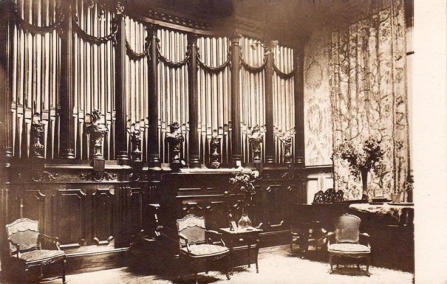
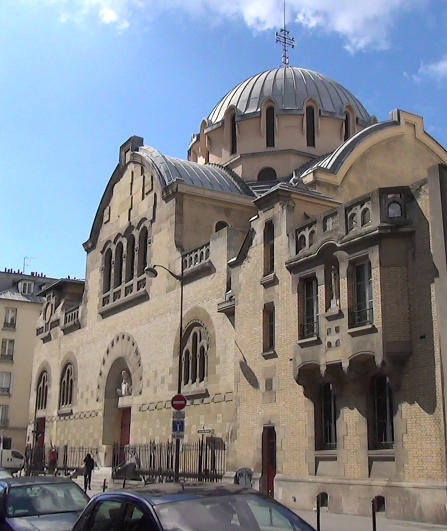
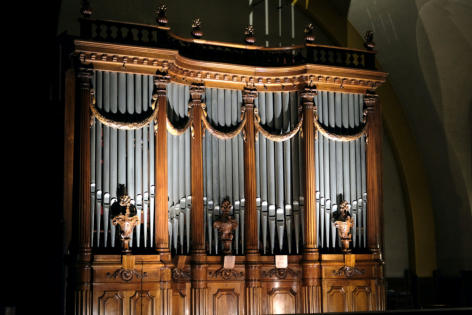
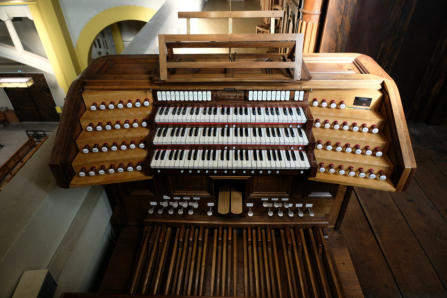
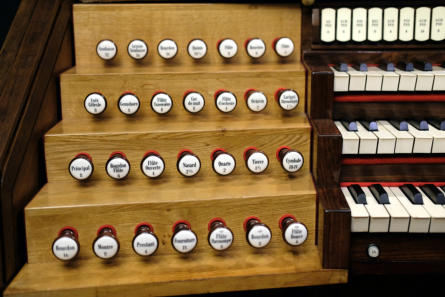

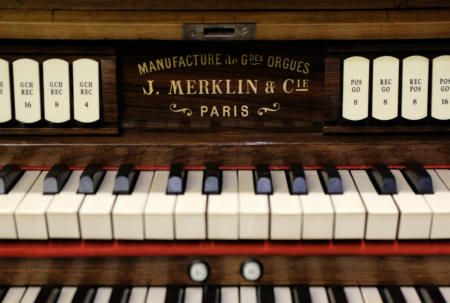
1904 - J. Merklin & Cie (1)
1924 - Joseph et Gaston Gutschenritter (2)
1945 - Jules Isambart et Jean Perroux (5)
1962 - Gutschenritter (Robert Masset) (3a)
2003 - Marc Hedelin (5)
2021 - Bernard Dargassies (4)
III/41 (34) - electro-pneumatical traction
composition

C3
Completed in 1921, the church of Saint-Dominique had a
large tribune to accommodate an organ. It is not known if
the parish had initially planned to build a new organ, but in
1926 it was decided to acquire the instrument of the Touche
Concert Hall (Boulevard de Strasbourg, Paris, 10th
arrondissement). It was an organ of 2 keyboards and
pedalboard, of 19 stops, built by the house Mutin-Cavaillé-
Coll. It was installed in Saint-Dominique by Gaston
Gutschenritter. This instrument had fine and delicate tones
but, shortly after its installation, its sound power was judged
clearly insufficient for the interior volume of the church and
the size of its dome. From the end of the 30s, the parish
considered replacing it, a project delayed by the war.
Fortunate circumstances led to the acquisition of a salon
organ (3 keyboards, 30 stops) belonging to Count Christian
Bertier de Sauvigny (1864-1939).
The instrument was built in 1904 by J. Merklin & Cie of Paris,
directed by Joseph Gutschenritter. Its drowned sideboard is
very elaborate, Louis XIV style. Its unusual design is
reminiscent of that of the great organ of the Saint-Sulpice
church. The instrument has been designed with very safe
taste and made with exceptional care. Modern for its time, it
was equipped with the tubular pneumatic transmission
system that had been developed by the Merklin house at the
end of the 19th century. The instrument was placed in a
spacious artist's studio in a mansion located rue Legendre in
the 17th arrondissement.
In the early 1920s, Count Bertier left the rue Legendre to
settle in a more spacious mansion rue de Poitiers. A room
was specially built in the courtyard of the latter to
accommodate the organ. While keeping its general
appearance the façade of the buffet was slightly reworked
and adapted to the dimensions of this new room, Count
Bertier took advantage of this move to increase the
instrument with three new stops. This move and
transformation was carried out by Joseph and Gaston
Gutschenritter (father and son). Musical mecca, concerts
were regularly organized each year (Gigout, Dallier, Dupré,
Duruflé, Fleury, Litaize, Langlais ...).
The instrument of the Concerts Touche was then installed in
the church of Saint-Antoine de Padoue (Paris 15) while that
of Count Bertier took place in Saint-Dominique in 1944-45. It
was Jules Isambart, organ builder, and Jean Perroux,
harmonist, both former workers of the illustrious Cavaillé-
Coll house, who were in charge of its installation. The
harmonist did his best according to the financial and
material means of the time to adapt the instrument to its
new place of adoption. The organ was inaugurated in
October 1945 by Marcel Dupré.
In the late 50s, the instrument showed signs of fatigue and
required restoration. Work was undertaken in 1961. The
pneumatic bed bases were kept but the transmissions were
electrified, this allowed the console to be moved away from
the buffet by placing it on one side of the stand. This
restoration, led by Robert Masset (successor of Gaston
Gutschenritter), profoundly changed the style of the organ.
His initial style, ultra symphonic no longer met the taste of
the time. The composition of the games and their
harmonization were modified in the neoclassical style,
aesthetics requiring clearer and higher tones. The
instrument was inaugurated in 1962 by Pierre Cochereau.
In 2002, Marc Hedelin restored all the pneumatic bed bases
and returned the console to its original location, in front of
the sideboard.
From 2019 to 2021, Bernard Dargassies and his associates
undertake a major restoration:
•
Restoration of throats
•
Restoration of façade pipes
•
Replacing the electric traction of the 60s with a digital
system
•
Console deported again on the side of the stand,
replacement of game controls (cat tongues) by wooden
tie rods with porcelain.
•
Added a combinator and a pedal cut.
•
dusting of piping and false box springs.
•
Changes in the composition of the stops and
harmonization in order to give a symphonic color to the
instrument, also with the aim of improving the
neoclassical contributions of the 60s.
•
Installation of a chamade on the roof of the organ.
The instrument was inaugurated in October 2021 by Julien
Lucquiaud, titular organist.
Text: Julien Lucquiaud, titular organist
Vidéo
The organs of Paris
Saint Dominique
16, rue de la Tombe-Issoire, 75014 Paris
ORGANS OF PARIS © 2024 Vincent Hildebrandt ALL ORGANS
C3
Completed in 1921, the church of Saint-Dominique had a
large tribune to accommodate an organ. It is not known if
the parish had initially planned to build a new organ, but in
1926 it was decided to acquire the instrument of the Touche
Concert Hall (Boulevard de Strasbourg, Paris, 10th
arrondissement). It was an organ of 2 keyboards and
pedalboard, of 19 stops, built by the house Mutin-Cavaillé-
Coll. It was installed in Saint-Dominique by Gaston
Gutschenritter. This instrument had fine and delicate tones
but, shortly after its installation, its sound power was judged
clearly insufficient for the interior volume of the church and
the size of its dome. From the end of the 30s, the parish
considered replacing it, a project delayed by the war.
Fortunate circumstances led to the acquisition of a salon
organ (3 keyboards, 30 stops) belonging to Count Christian
Bertier de Sauvigny (1864-1939).
The instrument was built in 1904 by J. Merklin & Cie of Paris,
directed by Joseph Gutschenritter. Its drowned sideboard is
very elaborate, Louis XIV style. Its unusual design is
reminiscent of that of the great organ of the Saint-Sulpice
church. The instrument has been designed with very safe
taste and made with exceptional care. Modern for its time, it
was equipped with the tubular pneumatic transmission
system that had been developed by the Merklin house at the
end of the 19th century. The instrument was placed in a
spacious artist's studio in a mansion located rue Legendre in
the 17th arrondissement.
In the early 1920s, Count Bertier left the rue Legendre to
settle in a more spacious mansion rue de Poitiers. A room
was specially built in the courtyard of the latter to
accommodate the organ. While keeping its general
appearance the façade of the buffet was slightly reworked
and adapted to the dimensions of this new room, Count
Bertier took advantage of this move to increase the
instrument with three new stops. This move and
transformation was carried out by Joseph and Gaston
Gutschenritter (father and son). Musical mecca, concerts
were regularly organized each year (Gigout, Dallier, Dupré,
Duruflé, Fleury, Litaize, Langlais ...).
The instrument of the Concerts Touche was then installed in
the church of Saint-Antoine de Padoue (Paris 15) while that
of Count Bertier took place in Saint-Dominique in 1944-45. It
was Jules Isambart, organ builder, and Jean Perroux,
harmonist, both former workers of the illustrious Cavaillé-
Coll house, who were in charge of its installation. The
harmonist did his best according to the financial and
material means of the time to adapt the instrument to its
new place of adoption. The organ was inaugurated in
October 1945 by Marcel Dupré.
In the late 50s, the instrument showed signs of fatigue and
required restoration. Work was undertaken in 1961. The
pneumatic bed bases were kept but the transmissions were
electrified, this allowed the console to be moved away from
the buffet by placing it on one side of the stand. This
restoration, led by Robert Masset (successor of Gaston
Gutschenritter), profoundly changed the style of the organ.
His initial style, ultra symphonic no longer met the taste of
the time. The composition of the games and their
harmonization were modified in the neoclassical style,
aesthetics requiring clearer and higher tones. The
instrument was inaugurated in 1962 by Pierre Cochereau.
In 2002, Marc Hedelin restored all the pneumatic bed bases
and returned the console to its original location, in front of
the sideboard.
From 2019 to 2021, Bernard Dargassies and his associates
undertake a major restoration:
•
Restoration of throats
•
Restoration of façade pipes
•
Replacing the electric traction of the 60s with a digital
system
•
Console deported again on the side of the stand,
replacement of game controls (cat tongues) by wooden
tie rods with porcelain.
•
Added a combinator and a pedal cut.
•
dusting of piping and false box springs.
•
Changes in the composition of the stops and
harmonization in order to give a symphonic color to the
instrument, also with the aim of improving the
neoclassical contributions of the 60s.
•
Installation of a chamade on the roof of the organ.
The instrument was inaugurated in October 2021 by Julien
Lucquiaud, titular organist.
Text: Julien Lucquiaud, titular organist
Vidéo
Organiste titulaire
Julien Lucquiaud
Concerts
-
Masses woth organ
Saturday 6:30, Sunday 9, 10:30 AM, 6:30 PM
Videos
Julien Lucquiaud
Photos de l’orgue : Julien Lucquiaud
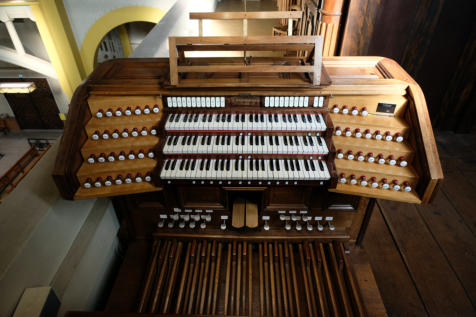
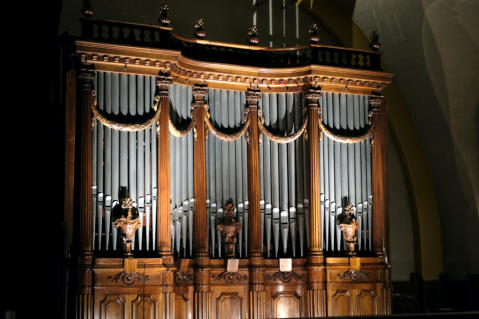
1904 - J. Merklin & Cie (1)
1924 - Joseph et Gaston Gutschenritter (2)
1945 - Jules Isambart et Jean Perroux (5)
1962 - Gutschenritter (Robert Masset) (3a)
2003 - Marc Hedelin (5)
2021 - Bernard Dargassies (4)






















